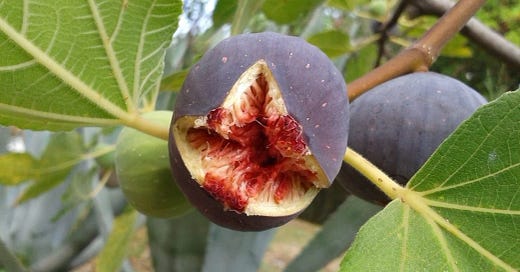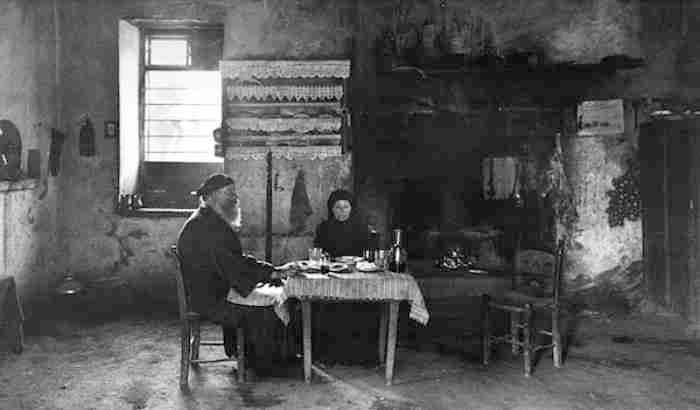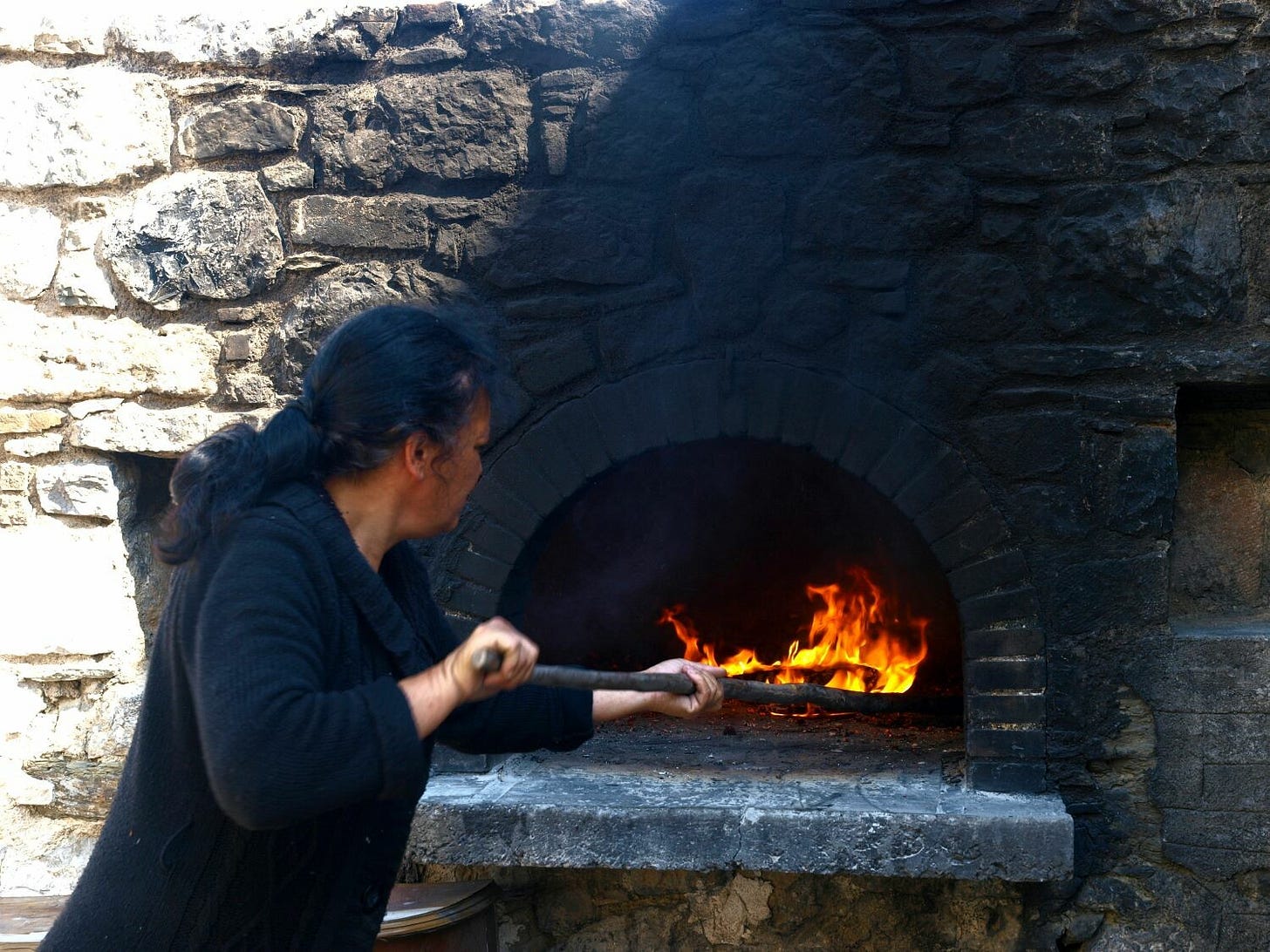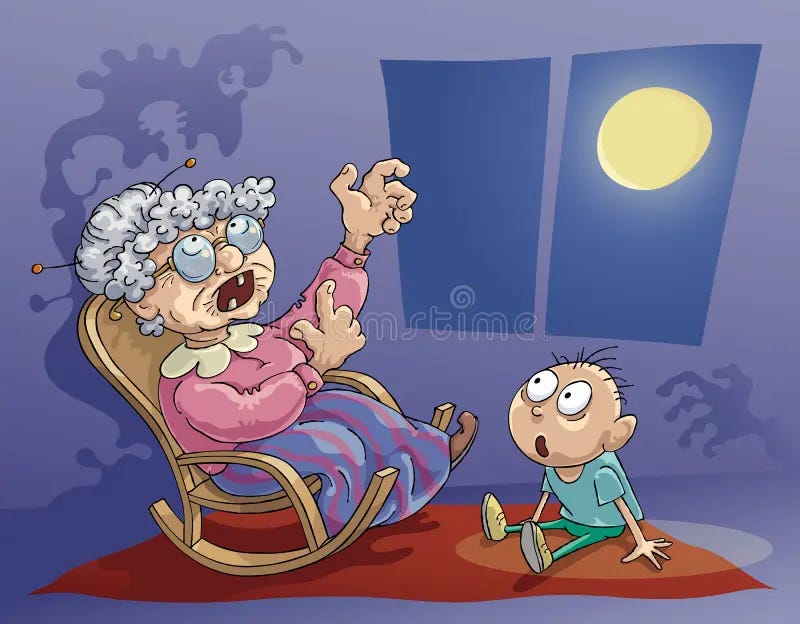Once upon a time there was a couple who had grown old. One winter evening, they sat by the hearth in the kitchen corner, and to pass the time they were roasting broadbeans and eating them. As they roasted them, a broadbean popped on the fire and flew onto the shelf. They raised their eyes to see where it had gone, and saw a small child sitting where the bean had landed. The elderly couple could not contain their joy.
“God,” said the man, “dear wife, God was keeping this child for our dotage.”
So they both started singing to him joyfully:
“Come on down, we’ll give you bread and cucumber, and send you to watch the donkey.”
The boy came down. They hugged it and kissed it and because it was small and odd, as if it had come out of a bean, so they called it Half-Bottom.
“Go now,” he said, “child, and watch the fig trees. And eat as much as you want.”
Half-Bottom took the food and went outside. He climbed a tree and ate some figs. A Lamia walked by and saw him, and began flattering him.
“Give me, Half-Bottom, give me a fig, I’m thirsty.”
“No I won’t, you’ll eat me.”
She said: “But by my riches, but by my goats, by my sheep, by my palaces, I won’t eat you.”
And Half-bottom was convinced. He climbed down and gave her a fig. As he handed it over, she grabbed him and popped him in her knapsack. As she took him home, Half-Bottom said:
“I need to pee.”
”Pee in there,” she replied.
”But how can I pee in here, I’ll get you all wet?”
”Fine,” she said, “I’ll let you out.”
And indeed, she took him out of the knapsack. But tiny as Half-Bottom was, he escaped her. He turned back and climbed back up the tree and sat down.
The next day, the Lamia passed by again. The same thing happened… she swore blind… and so on. In the end she convinced Half-Bottom to give her the fig, and in the sack he went again. The same thing happened on the road. Half-Bottom demanded to pee, but the Lamia wouldn’t hear of it. She got him home and said to her daughter:
“Maroula, I brought you a first-class snack. Tomorrow morning it’s Sunday and I’m going to church. You’ll slaughter him and put him in the oven, so we can eat and enjoy it. I’ll go and invite the relatives so they can eat too.”
“Very well, mother,” she said, “I’ll prepare him.”
Before that, they slept peacefully. The old Lamia rose at dawn, washed, combed her hair, tidied herself, and went to church. So Maroula left, and went down to the store room where they’d locked him up, to roast him. She’d heated the oven and everything was ready to roast him. But, as he looked sleepy, she picked him up with the shovel, but he didn’t balance on it. The cunning boy was doing it on purpose and kept shifting his weight.
“You don’t know how,” Half-Bottom said to Maroula.
”But you won’t stay still,” she said to him. “Sit still, I need to roast you, otherwise there’ll be hell to pay from my mother.”
Half-Bottom said: “You don’t know how, let me show you how. I’ll get off the shovel and you get on, so I can show you.”
And she said, “very well.”
So Maroula got on the shovel and Half-Bottom gave her a push and put her in the oven. He cut off her head and put it on the pillow and covered it up and it looked just as if she was sleeping.
At lunchtime, the old Lamia came home. And as she saw her daughter’s head on the bed she thought, “leave her, let her rest, the poor thing must be tired from the cooking.”
So the guests arrived and sat at the table, and the old Lamia got the meat out of the oven and put it on the table. They sat and ate. Now and then the Lamia shouted to her daughter “Maroula, come and eat.” And she heard a voice say:
You eat Maroula, you call Maroula
you’re eating her, don’t you feel sick?
The Lamia looked high and low to find the source of the voice. She got up and went to the bed, and what did she see? Maroula’s cut off head.
”What horror!” she said, “that damned child Half-Bottom played this trick on me!”
The Lamia started searching for the source of the voice. Finally she looked on the roof and saw Half-Bottom. To catch him, she pretended to be nice.
“But how did you get up there, Half-Bottom, my dear little boy?”
”I put one serving dish on top of the other and I climbed up.”
So the Lamia put one serving dish on top of the other, and as she stepped on them, they all fell and broke.
“Come, how did you get up there, Half-Bottom, my dear little boy?”
”I stacked knives and forks and I climbed up.”
So the Lamia stacked knives and forks, and as she stepped on them, they all collapsed, she fell on top of them, and was stabbed to death. Then Half-Bottom climbed down and finished her off.
Then he went home, told the elderly couple, and they went and took all the Lamia’s things, and they lived happily ever after.
Translation and commentary by Sasha Chaitow © 2025.
About this wondertale
Half-Bottom is my translation of “Misokolakis” (the traditional name of the story, literally meaning Half-Bottom).
This story was told to my partner by his grandmother when he was a child: it terrified him and stayed with him for decades. He had no idea it was a traditional wondertale; he thought his grandmother had made it up.
Indeed, she had embellished it, so “Half-Bottom” was described as half a boy sliced length-wise, with one leg, one arm, one eye and so on; the “stacked knives and forks” of the final scene became a staircase with the characters balancing on the fork tines and knife points, which made for quite a horrifying scene for a small child to hear as a bedtime story! I came across it recently while collecting material for Thyrathen and decided to share it in honour of his childhood nightmares, as we’ve had quite a therapeutic laugh about it.
The Lamia referred to in the story is the medieval urban (Byzantine) evolution of the mythical Lamia of Lybia: a beautiful queen beloved of Zeus, whose children were killed by Hera. In her grief, Lamia turned into a child-killing monster, and Hera cursed her to never sleep, but Zeus gave her the gift of prophecy. Calabrian poet Stesichoros claimed that Scylla and Triton were her surviving children. Since Hellenistic times the Lamia (also known as Mormo, Mormokelion, Mormolykeia, Gello/Yello, Abyzou) became a kind of bogey(wo)man with which to frighten children, and is found in many folktales and records attested in Byzantine literature and proverbs. More on this in next week’s instalment featuring a baby Gello!
This version of the story of little Half-Bottom was narrated in the early twentieth century by the seventy-year-old Maria Karamaliki from Lykoudi, Zakynthos, and recorded by folklorist Marietta Minotou (d. 1960), in “Wondertales from Zakynthos,” Laografia (Folklore) 11:18, p. 465-468. My partner’s grandmother who also knew the story was from Kalymnos, an Aegean island.
It is classified under the Aarne-Taylor category AT327C: “The Devil [Witch] carries the hero home in a sack,” and is related to a category of folktales including Rumpelstiltskin (there are 43 recorded types in total). The main motifs are those of the tiny changeling that mysteriously appears from a bean or similar, usually to elderly or wretched parents, and the hero’s struggle to escape the witch/monster, who kidnaps and puts him in a sack, but the hero manages to turn the tables and slay the monster through cunning, and brings riches to the parents. It also belongs in a wider category of cannibalistic folktales, which form a whole subgenre of their own in Greek (and worldwide) folklore.
Source of story and part of commentary: Anna Angelopoulou, Greek Wondertales B’: The Cannibal [Tales], Athens: Estia, 2004.
Read more Greek folk horror and wondertales here.










Thank you Sasha, I’m glad to have read this now and not when I was little! I had nightmares back then about the Struelpeter stories! I’ll copy this for an elderly recently widowed friend in Athens. I think she’ll appreciate it. 😘
I jumped when I saw this story in my inbox as only just last week I had come across Lamia in the context of half woman up top and half serpent waist down and I can see how this archetype was assigned serpentine qualities especially in reference to the gift of prophecy but also the act of swallowing small children makes me think of an anaconda swallowing children or small animals